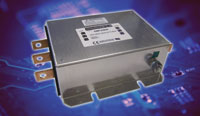
Posted to News on 20th Mar 2015, 00:00
Halting harmful harmonics
The rise of non-linear loads in industrial environments over the last two decades has resulted in a growing problem of harmonic currents and voltage distortion, and the industry has struggled to implement effective mitigation techniques. John Mitchell of CP Automation explores active and passive filtering.

>Across industry, voltage distortion caused by current harmonics can wreak havoc on the plant, its equipment and the mains power supply. Damage can be serious and varied with the most common symptoms including voltage notching, motor vibration, arcing on bearings, nuisance tripping, electromagnetic interference (EMI/RFI) and overheating. The thermal stress on components can cause them to wear out quicker and inefficiency through heat loss results in increased energy costs in the long term.
>The last few decades have seen a rise in the use of non linear loads such as transistor based variable speed drives (VSDs) and line commutated DC drive systems. The processes of high frequency switching and pulse width modulation (PWM), introduce unwanted multiples of the fundamental 50Hz frequency in the form of harmonics.
>Various approaches have been used to combat harmonics over the years. This has led to many suppliers using setups which are not meant for harmonic mitigation, in configurations that are often unnecessarily complex, outdated, and which take up lots of space or are inefficient, ultimately raising costs.
>There is the added issue of meeting international harmonic control requirements such as IEEE 519 which limits "the maximum frequency voltage harmonic to 3% of the fundamental and the voltage total harmonic distortion (THD) to 5% for systems with a major parallel resonance at one of the injected frequencies." Some form of filtering is subsequently recommended.
>Passive and active solutions can be installed in both series and parallel (shunt) configurations. Series solutions operate in line with the load, meaning that units must be sized for the full current load. Shunt units can be sized only for the harmonic disturbance. There is a clear decision to be made between series-passive, shunt-passive, series-active and shunt-active solutions.
>The most straightforward series-passive solution can be achieved using a line reactor. This is a three-phase choke placed in front of the rectifier. A line reactor provides a low cost way to reduce current harmonics, whilst adding a level of protection to the rectifier. However it's not perfect, it's not suitable for large drives and on its own will be unable to meet IEEE 519 standards.
>The next option is to use a series harmonic filter. It provides more effective compensation than a line choke, significantly reducing total harmonic distortion (THD). Although a series harmonic filter works well as a 'catch-all' it is grid sensitive and may lead to interaction. It's also bulky and not particularly suited to dynamic applications, working best on pumps and fans on a reasonably well balanced supply.
>Of course, truly balanced supplies are few and far between. Any unbalance on the supply can cause damage as a result of overloading and overheating. Series harmonic filters lack upgradeability, monitoring and redundancy, meaning that if the filter fails, the drive fails.
>The last series-passive solution is multi-pulse, which is a multi-winding transformer with phase shift in the windings. Because every secondary winding has its own rectifier, an 18-pulse configuration can target and effectively cancel out the 18th, 19th, 35th and 37th harmonics.
>The downside of using multi-pulse is that it's very sensitive to voltage unbalance. On an 18-pulse drive under 50% load, when the unbalance is increased from 0% to 3% the current THD increases from 10% to 35%. At less than 100% load, the current THD doubles from 8% to 16%. When using multi-pulse, consideration needs to be given to planning the drive system and deployment as units are often large, heavy and difficult to retrofit.
>An inherent weakness of passive solutions is the inability to control the load. The grid loading, along with the filter's impedance, can cause several fine-tuned shunt filters to interact, resulting in resonance with other equipment.
>Series-active takes the form of an active-front-end (AFE) VSD. It replaces the rectifier diodes in a regular VSD with an IGBT controlled rectifier to eliminate switching based signal noise. This circuitry also allows the AFE to introduce regenerative braking. Although this unit may at first seem to eliminate harmonics, it must be noted that with the AFE in addition to the VSD, there are now two drives in the circuit producing heat, so bigger cooling systems will be needed.
>AFEs are great at significantly lowering THD and maintaining good power factor. However AFEs have some serious drawbacks. In order to maintain a small form factor, lower switching frequencies are used, which result in high switch ripples on the voltage waveform. This can cause equipment to nuisance trip and malfunction.
>AFEs are generally a plant level solution; separate regenerative units can be used only where necessary to lower capital expenditure and increase return on investment (ROI).
>A final option, shunt-active filtering, uses IGBT technology and is particularly suited to VSD harmonics. It is able to cancel out harmonic frequencies by injecting equal and opposite, phase shifted, current frequencies.
>Shunt-active filters provide the most efficient harmonic compensation in a compact unit which has little loss, is insensitive to grid conditions, cannot be overloaded and is easy to retrofit. Also, being parallel to the load allows redundancy to be built in. All of this comes at a slightly higher cost, which is offset by the better return on investment over the longer term. The units are sized for the actually harmonic current produced and therefore are in the order of 25-33% of the drive rating.
>Effective harmonic mitigation may seem intimidating, but it doesn't have to be. Understanding the often subtle differences between various techniques can yield better cost savings, reduce complexity and prolong equipment life.
Unit 8, Ashley Industrial Estate
Exmoor Avenue
DN15 8NJ
UNITED KINGDOM
+44 (0)1724 851515






